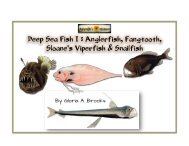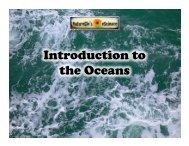LessonThreeNeSGeometricBeautyofSnowflakesPrt3Rvsd121016.pptx
Create successful ePaper yourself
Turn your PDF publications into a flip-book with our unique Google optimized e-Paper software.
The Geometric Beauty of Snowflakes:<br />
Snow Crystal Geometry
Snowflake Types<br />
illustrated with<br />
Wilson Bentley’s<br />
snowflake<br />
photography in the<br />
public domain unless<br />
otherwise noted.<br />
On the following slides,<br />
please note the connections<br />
between the snowflakes<br />
beauty and their geometric<br />
descriptions and varieties.
Overview of Some of the<br />
Mathematics Found in Snowflakes<br />
Symmetry<br />
• Rotational symmetry – snowflake rotated or turned &<br />
still looks same<br />
• Reflection or mirror symmetry – one half of snowflake<br />
image is reflection of other half<br />
• 6-fold symmetry (Stellar dendrite snowflake types) –<br />
hexagon looks same after being rotated 360° for 6<br />
turns about its axis<br />
• 3-fold symmetry (truncated triangular) - triangle looks<br />
same after being rotated 360° for 3 turns about its axis
Snowflake Lines<br />
Lines<br />
• Perpendicular lines – 2 lines intersecting or<br />
meeting at a right angle or 90°<br />
• Parallel lines – 2 lines always at same distance<br />
from each other but never touch<br />
Left image -<br />
The red &<br />
yellow lines are<br />
perpendicular<br />
to each other.<br />
Right image – The<br />
two yellow lines are<br />
parallel to each other<br />
and the two red lines<br />
are parallel to each<br />
other.
Simple Hexagonal<br />
Prisms<br />
• Basic hexagonal snow<br />
crystal geometry<br />
• Grow into thin plates or<br />
slender hexagonal columns<br />
• Barely seen with eyes<br />
• Facets rarely perfectly flat<br />
• Decorated with beautiful<br />
indents, ridges, or other<br />
features
Hexagonal Plate Geometrics:<br />
Rotational Symmetry<br />
• A regular hexagon<br />
• Rotational symmetry<br />
definition – at every turn,<br />
hexagon looks same at<br />
each turn<br />
• Nature’s snowflakes<br />
mostly asymmetrical<br />
because of atmospheric<br />
conditions & melting as<br />
flakes falls to earth<br />
Point of<br />
intersection of<br />
each symmetry<br />
line of axis (red<br />
lines)<br />
Imagine turning or rotating this hexagon to the right around its center point and<br />
stopping at each new hexagonal point until it rests where you began turning it by<br />
following the yellow arrows. Using the blue ball as a reference marker, imagine<br />
moving it to its next point, one point at a time. How many turns until the blue ball<br />
reaches its original resting position? Answer on next slide.
Hexagonal Plate Geometrics:<br />
Reflection Symmetry<br />
• Reflection symmetry – mirror image of itself or<br />
half of image reflects other side<br />
• Below diagram: observe how yellow square, blue<br />
triangle & red circle are “reflected” like a mirror to<br />
other hexagon side<br />
1<br />
6<br />
1<br />
6<br />
2<br />
5<br />
2<br />
5<br />
3 4<br />
3 4<br />
Answer from slide #5 – “How many turns until the blue ball reaches its original resting position?” 6 turns
Stellar Plates<br />
• Common<br />
• Thin, plate-like crystals<br />
• Star-like shapes<br />
• 6 broad arms<br />
• Elaborate faces with<br />
symmetrical markings<br />
• Temperature Formations<br />
- near -2 C (28° F) or near<br />
-15 C (5° F)<br />
• 6-fold rotation &<br />
reflection symmetries<br />
What are these lines called<br />
again? Answer on next slide.
Sectored Plates<br />
• Stellar plates<br />
• Hexagonal<br />
• Complex<br />
• Prominent ridges on<br />
broad, flat branches<br />
• Geometrics – 6-fold<br />
rotation & reflection<br />
symmetries<br />
Answer to slide #8’s ques2on, “What are these<br />
lines called again?” Symmetry lines or lines of axis
Stellar Dendrites<br />
• Dendritic - "tree-like”<br />
• Plate-like<br />
• With branches and side branches<br />
• Size - usually 2-4 mm in diameter<br />
• Seen with eyes and or magnifying glass<br />
• Most popular snow crystal<br />
• Used in holiday decorations<br />
• Geometrics – 6-fold rotation & reflection<br />
symmetries
Fernlike Stellar Dendrites<br />
• Multi side branches<br />
• Fernlike<br />
• Many fractal or self-similar<br />
• Largest snow crystals<br />
• Diameter – 5 mm or more<br />
• Some snowfalls contain<br />
only stellar dendrites and<br />
fernlike stellar dendrites<br />
• Geometrics – 6-fold<br />
rotation & reflection<br />
symmetries
Hollow Columns<br />
• Small; need magnifier to view<br />
• Symmetrical hexagonal hollow regions<br />
• Air bubbles sometimes found inside<br />
• Geometrics: tall, narrow, hexagonal,<br />
columnar, prisms<br />
• What’s a prism? solid object with two<br />
identical ends and flat sides<br />
What shape is<br />
this found on<br />
both ends?<br />
Image in the Public Domain
• Slender, columnar ice<br />
crystals<br />
• Temperature growth: -5 C<br />
(23 F)<br />
• Resemble white hair bits<br />
• Mystery: growth change<br />
from thin flat plates to<br />
long needles with<br />
temperature changes<br />
• Geometrics – needles are<br />
straight lines<br />
Needles
Capped Columns<br />
• 2 thin, plate-like crystals<br />
growing on ice column ends<br />
• Blow into cloud region<br />
where growth becomes<br />
plate-like<br />
• Grow into stubby columns<br />
• Geometrics – 6-fold<br />
symmetrical hexagonal<br />
plates (both capped ends)<br />
with rotation & reflection<br />
symmetries<br />
Rime on both ends of a<br />
columnar snow crystal.
Double<br />
Plates<br />
• Double capped column<br />
• Short central column<br />
• One hexagonal plate grows out faster and<br />
shields other from water vapor source<br />
• Geometrics – columnar with two hexagonal<br />
rotation & reflection symmetrical plates on<br />
both ends
Triangular Crystals<br />
• Rare<br />
• Temperature growth - near -2 C (28° F)<br />
• Can grow as truncated (cut tips; see examples<br />
below) triangles<br />
• Sometimes plate corners sprout branch-like arms<br />
with unusual appearance<br />
• Geometrics – truncated or non-truncated<br />
triangles; 3-fold rotation & reflection symmetries
Snowflake Fractals<br />
• Fractal – a<br />
never<br />
ending self<br />
similar<br />
pattern<br />
across<br />
different<br />
size scales<br />
• Crystalline<br />
arms branch<br />
into<br />
increasingly<br />
smaller sizes<br />
• Branching<br />
consistent<br />
repeatable<br />
pattern at<br />
smaller and<br />
smaller scales<br />
• Common with<br />
fern-like<br />
stellar<br />
dendrites<br />
• Other fractal<br />
examples:<br />
rivers, trees,<br />
coastlines,<br />
mountains, &<br />
abstract<br />
through<br />
computer<br />
generation
Visit Natureglo’s eScience MathArt Virtual<br />
Library’s Snowflake resource page at:<br />
http://hascmathart.weebly.com/snowflakes.html<br />
Background image –<br />
“Heavy snow”. By<br />
Steve Webster
References<br />
1. Kenneth Libbrecht (Winter 2004/2005). "Snowflake Science". American<br />
Educator. Retrieved 2009-07-14.<br />
2. Alaska Air Flight Service Station (2007-04-10). "SA-METAR". Federal<br />
Aviation Administration via the Internet Wayback Machine. Archived from<br />
the original on 2008-05-01. Retrieved 2009-08-29.<br />
3. Nelson, Jon. "Branch Growth and Sidebranching in Snow Crystals".<br />
4. Bohannon, John. "ScienceShot: The True Shape of Snowflakes".<br />
ScienceNOW. American Association for the Advancement of Science.<br />
Retrieved 12 April 2013.<br />
5. Jon Nelson (2008-09-26). "Origin of diversity in falling snow".<br />
Atmospheric Chemistry and Physics. Retrieved 2011-08-30.<br />
6. Nelson, Jon. "The Six-fold Nature of Snow”.
Thank you for watching!<br />
Most of the black and white images, save for the ones otherwise noted, are<br />
Wilson Bentley’s, the “Snowflake man” and are in the public domain.











